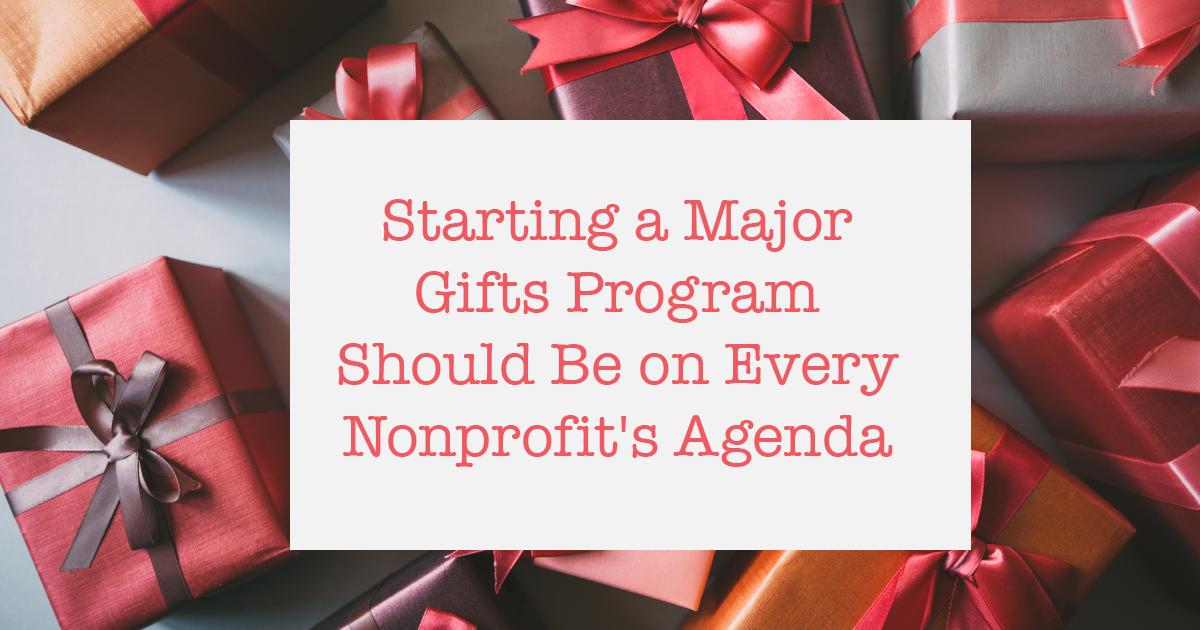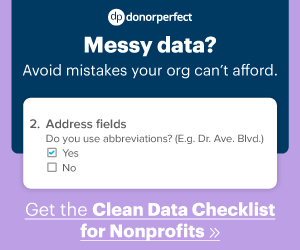
Starting a Major Gifts Program Should Be on Every Nonprofit’s Agenda
For nonprofits that question whether their organization is too small to have a major gifts program, the answer is clear: Even the smallest nonprofits, in most cases, should establish a robust major gifts effort.
The following will help:
STEP 1: Determine your organization’s major gift level.
Examining the donations you received during the past three years will tell you what you’ve received, but that may not adequately indicate what your major gift level could be. Consider looking at donors who are loyal to your cause, those who have indicated a planned gift to your organization, and those who may support other similar organizations in the community.
STEP 2: Identify your organization’s significant donors by running a report of the organization’s larger donors from the past two to five years.
Track cumulative giving to identify donors who make regular, small donations throughout the year that (can) add up to major amounts. Include every gift, event ticket purchases, responses to appeals, online donations, etc. Keep levels small enough to capture potential wealth from lower-dollar donors who have the potential to donate more, even if they currently are not a large donor.
STEP 3: Identify your organization’s loyal donors.
Loyal donors are those who give year after year, regardless of amount. Set the criteria to include those who have made gifts seven or more times in the last decade. Don’t exclude donors just because they have skipped a year or two. Do not set parameters on the number of gifts made.
STEP 4: If needed, determine if your list needs to be wealth-screened.
After identifying the largest and most loyal donors, go through the files and remove corporations and foundations. The only foundations that should be on the list are those of individuals or families that do not require an application process. If your donor file is too small, you may need to rerun the largest donors list to include lower-level donors. Merge the two lists.
STEP 5: If needed, send the list (target approximately 2,000) to a chosen vendor for wealth-screening.
Wealth screening is a powerful tool that nonprofits can use to help determine donors’ capacities to give. A subset of prospect research, wealth screening looks at top indicators of wealth like real estate ownership, business affiliations, and stock holdings in public companies. There are a number of different wealth screening vendors on the market today that an organization can contract with for services.
STEP 6: Hold a prospect rating session with staff, board, and development committee members to discuss each name and to comprise a list of the top 20 major gifts prospects.
This rating session should consider individual capacity and inclination when determining the priority score of the prospects. A decision must be made as to the best method of ratings to use for the prospect screening session (i.e., group discussion ratings, group/individual ratings, individual/one-to-one ratings, or individual/solitary ratings).
STEP 7: Develop a “Tier 1” list of 20 prospects, including donors who rank high on donation amount, loyalty, capacity, and interest.
These Tier 1 prospect are the people you have identified as having the greatest potential, and therefore will require more of your time and attention. Be sure that you develop outreach and cultivation plans for each of the donors identified and listed on the Tier 1 list to continue to move the relationship.
STEP 8: Develop a “Tier 2” list of 20 prospects. This list should include donors who have the ability and interest, even if they lack sufficient connection to the organization.
These will be the people you’ll want to cultivate over the next two years or so, depending on the individual needs of each donor in order for them to become Tier 1 prospects. You’ll need to develop an outreach and engagement program that draws them closer to your nonprofit. Volunteering is a proven way to foster commitment, which often spurs additional donations.
STEP 9: Develop a “Tier 3” list of 20 prospects for which additional research needs to be conducted to find out more information.
Fundraising is a long-term process, which is why “development” is used when talking about cultivating financing sources. You need to learn if Tier 3 prospects have the interest in engaging with your organization. One way to start your research is by inviting these prospects to an reception where they can meet Tier 1 and Tier 2 prospects.
STEP 10: Implement personalized cultivation and solicitation strategies for each prospect.
Most importantly, keep accurate records of all interactions—personal, organizational, email, direct mail, etc.—with all prospects. Assess each interaction, to the extent possible. Convene your development committee at least once a quarter to review actions and results to date and to plan next steps.
_________________________________________
Robin Cabral is “Hire a CFRE!” the one and only outsourced development professional with close to twenty-five years experience providing value-added consulting services with razor-sharp monthly result objectives and benchmarked deliverables.
She works with mid-sized nonprofits that want to position themselves to build capacity and generate MORE fundraising prospects, BETTER donor relationships, and BIGGER fundraising dollars. She specializes in providing outsourced, interim development services and assisting smaller organizations in their first campaigns; annual, capital, and endowment.
Find out more at www.developmentconsultingsolutions.com.
Follow her on LinkedIn, Like her on Facebook, and on Twitter: @HIREACFRE!








